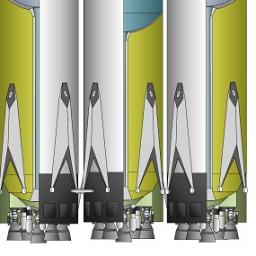The SpaceX Nine Raptor Mars Rocket
 The ever-improving Raptor rocket engine from SpaceX has mutated to a 1Mlbf (4,500kN) gas-gas (full flow) liquid methane and oxygen engine. With nine such engines in an arrangement that could dwarf even the Saturn V, can Musk and his team finally shoot for Mars?
The ever-improving Raptor rocket engine from SpaceX has mutated to a 1Mlbf (4,500kN) gas-gas (full flow) liquid methane and oxygen engine. With nine such engines in an arrangement that could dwarf even the Saturn V, can Musk and his team finally shoot for Mars?
Anyway, regarding methane, the ease of manufacture is definitely part of it, but there's more.
Two important, and largely at-odds, characteristics of a rocket fuel are that it must produce low-molecular-weight exhaust products, which maximizes Isp, and that it must be high-density, so a smaller volume is required, so the tankage weighs less. In the same vein, cryofuels are slightly worse than noncryos of the same density, because of the added mass of insulation required.
Hydrogen is a popular choice (particularly for upper stages) because its exhaust products (H2O, H2*) are the lightest you can get in a practical** chemical rocket.
Kerosene is also popular (particularly for 1st stages) because it's about 7x as dense as hydrogen, and not a cryofuel.
Methane is a chance to split the difference -- it's roughly 6x as dense as liquid hydrogen (it still has the cryofuel insulation penalty, though), but it has relatively light exhaust gases (2:1 H2O/CO ratio) compared to long hydrocarbons (H2O/CO ratios approach 1:1 for long-chain alkanes, and are 1:1 for simple cycloalkanes).
* fuel-rich mixtures are generally used for a combination of reasons (see Ignition!) including better exhaust mixture (H2 vs. H2O, or for hydrocarbons CO vs. CO2).
** such devices as Rocketdyne's test motor burning liquid lithium, liquid fluorine, and gaseous hydrogen (see Ignition!) are fascinating when viewed from a sufficient distance, but if that's what you would term practical, please tell me where you live and/or work so I can stay well clear.